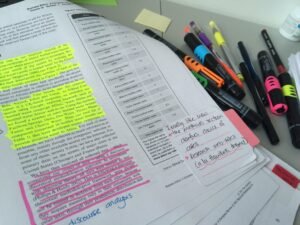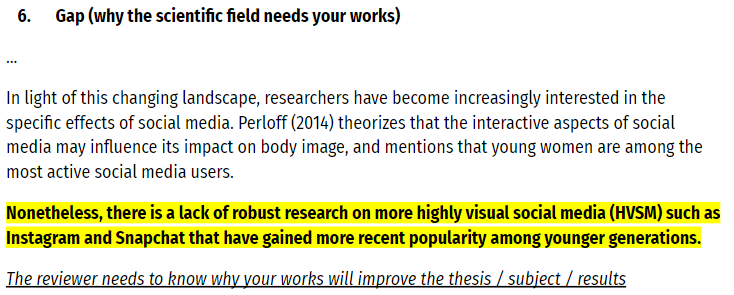After understanding your problematic, issued your proposal research, and designed your conceptual and mental maps, it is time to write a state of the art or literature review.

Page contents
ToggleBefore writing a state of the art
There are several reasons to do a literature review at the start of a research project:
- To familiarize yourself with the current state of knowledge on your subject
- To make sure you're not just repeating what others have already done
- Identify knowledge gaps and unresolved problems that your research can solve
- To develop your theoretical framework and your methodology
- Give an overview of the main results and debates on the subject
Writing the literature review shows your reader how your work relates to existing research and what new insights it will provide.
To start organizing the argument and structure of your literature review, you need to understand the connections and relationships between the sources you have read. Based on your readings and notes, you can search for:
- Trends and patterns (in theory, method or results): Do certain approaches become more or less popular over time?
- Themes: what questions or concepts come back in the literature?
- Debates, conflicts and contradictions: where do the sources disagree?
- Pivotal publications: Are there any influential theories or studies that have changed the direction of the field?
- Gaps: what is missing from literature? Are there any weaknesses to correct?
This step will help you develop the structure of your literature review and (where appropriate) show how your own research will contribute to existing knowledge.
Note that the literature review comes after the introduction in any article!
We will see later how write your introduction (you already get some tips in the previous lessons).
Introduction to literature
The introduction should clearly establish the direction and purpose of the literature review.
Review of thesis literature
If you are writing the literature review as part of your dissertation or thesis, repeat your central problem or research question and provide a brief summary scientific context. You can emphasize the topicality of the topic ("many recent studies have focused on the problem of x") or point out a gap in the literature ("although there has been a lot of research on x, few researchers have taken into consideration").
Literature review of an article
If you are writing a stand-alone article, provide background information on the topic and its importance, discuss the scope of the literature you will review (e.g., the time period of your sources), and state your purpose. What new perspective will you gain from literature?
State-of-the-art structure
It's important to show that you know the most important research on your topic. A thorough literature review convinces the reader that your project has a solid foundation of existing knowledge or theory. It also shows that you're not just repeating what other people have already done or said.
In this section, aim to demonstrate exactly how your project will contribute to conversations in the field.
- Compare and contrast: what are the main theories, methods, debates and controversies?
- Be critical: what are the strengths and weaknesses of the different approaches?
- Show how your research fits into the framework: how will you develop, challenge or synthesize the work of others?
If you're not sure where to start, read our guide on how to write a literature review.
By looking through the different sections of an article, you can try to find simple answers to “What,” “How,” and “Why.” Follow the list to understand what answers you should try to look for in each section of a research paper:
- Introduction:
- What is the research question and how is the author trying to answer it?
- Does the author make an assumption in the introductory part?
- Methods :
- What type of methods were adopted?
- What was the sample size for data collection and how was it analyzed?
- Results :
- What were the most vital findings from the experiments carried out?
- Do the results confirm the hypothesis that was made?
- Discussion/Conclusion
- What is the final solution to the research paper problem statement?
- What is the author's explanation for the results obtained?
- What is the inference drawn from the observations?
- What recommendations does the author make?
- What are the different limitations of the study carried out?
Just like the abstract, the purpose of an abstract for the research paper will be to give the audience a brief overview of what this study says. You will need to find out what information is relevant and explain it briefly but completely.
All first drafts of your review articles should follow the order of the original article. The structure would look like this:
- State the research question and explain why it is important.
- Indicate the hypotheses that were tested.
- Describe the methods in a few paragraphs (participants, design, procedure, materials, independent and dependent variables, how they analyzed the data)
- Discuss the results and explain why they were significant.
- State what the main implications were and do not exaggerate the importance of their findings.
- The results and their interpretation must be directly linked to the hypothesis.
This first draft of research paper abstract writing should focus on content rather than length. There is a good chance that further condensing will be necessary, but this will need to be done after several re-readings to condense the information that will be useful to you.
A very important step is your discussion of the article. Any research work can be interpreted differently depending on the researchers and the research context. Therefore, you must remain critical of the summary you provide. The last paragraph of your summary is therefore a critique or an interpolation of the paper in relation to your context and your problem.
The body
Depending on the length of your literature review, you can divide the body into subsections. You can use a subtitle for each theme, period or methodological approach.
As you write, you can follow these tips:
- Summarize and synthesize: provide an overview of the main points from each source and combine them into a coherent whole
- Analyze and interpret: don't just paraphrase other researchers; add your own interpretations where possible, discussing the importance of the results in relation to the literature as a whole
- Critically evaluate: mention the strengths and weaknesses of your sources
- Write in well-structured paragraphs: use transition words and topic sentences to make connections, compare and contrast
Example of state-of-the-art construction
Here is an example in English of the construction of a state of the art.






Conclude your state of the art
In the conclusion, you should summarize the main findings you have drawn from the literature and emphasize their importance.
Review of thesis literature
If the literature review is part of your thesis or dissertation, show how your research fills gaps and contributes new knowledge, or explain how you drew on existing theories and methods to build a framework for your research .
Literature review of an article
If you are writing a stand-alone article, you can discuss the overall implications of the literature or make suggestions for future research based on the gaps you have identified.